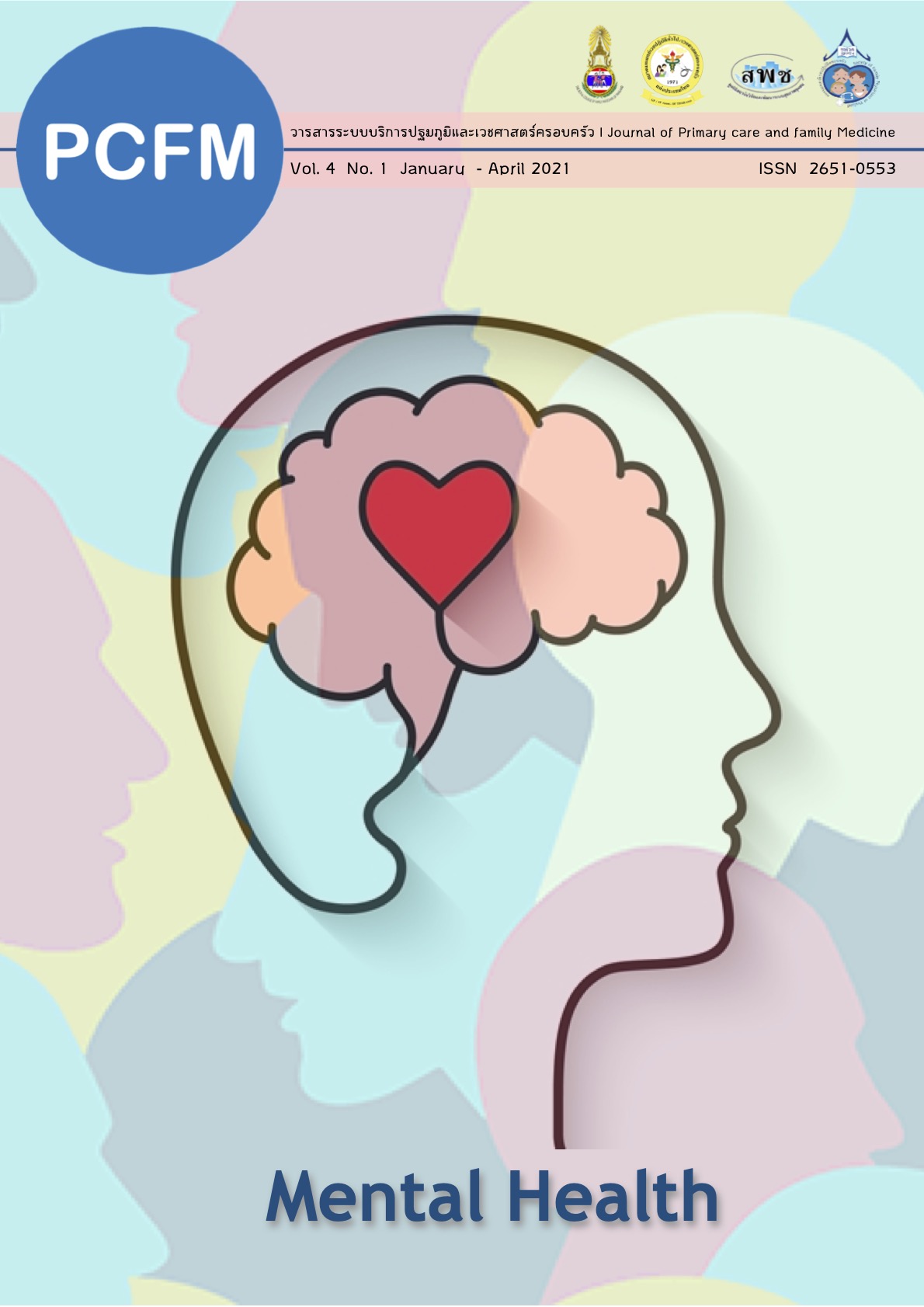ผลของการวางแผนการดูแลล่วงหน้าต่อการดูแลในวาระสุดท้ายของชีวิต ในคลินิกการดูแลประคับประคอง รพ. แม่สอด จ. ตาก
Main Article Content
บทคัดย่อ
ที่มา: การวางแผนการดูแลล่วงหน้า (Advance Care Plan: ACP) เป็นหนึ่งในกระบวนการดูแลผู้ป่วยระยะท้ายแต่การศึกษาเกี่ยวกับผลของการวางแผนการดูแลล่วงหน้ายังมีจํากัด
วัตถุประสงค์: ศึกษาผลของACP ต่อการใส่ท่อช่วยหายใจและสถานที่การเสียชีวิต
วิธีการศึกษา: การศึกษาจากเหตุไปหาผลแบบย้อนหลัง(retrospective cohort study)
ผลการศึกษา: ร้อยละ81.8 เป็นผู้ป่วยมะเร็งจากผู้ป่วยประคับประคอง292 รายได้ACP ร้อยละ74.3 โดยเป็นกลุ่มที่ทําการวางแผนการดูแลล่วงหน้าแบบผู้ป่วยและครอบครัวมีส่วนร่วม(Family Care Plan: FCP) ร้อยละ 28.1 และกลุ่มที่ครอบครัวเป็นผู้กําหนดการวางแผนการดูแลล่วงหน้า(Conventional Advance Care Plan: cACP) ร้อยละ 46.2 พบว่าcACP ลดโอกาสการใส่ท่อช่วยหายใจ(OR = 0.08, 0.015 - 0.423) ผู้ป่วยมะเร็งจะมีโอกาสใส่ท่อช่วยหายใจน้อยกว่าผู้ป่วยที่ไม่ใช่มะเร็ง(OR = 0.291, 0.100 - 0.847 ) ส่วนACP ไม่มีผลต่อสถานที่การเสียชีวิตปัจจัยที่มีผลต่อการเสียชีวิตที่โรงพยาบาลคือการศึกษาสูง (OR 10.627, 2.074 - 54.397) การวินิจฉัยมะเร็ง(OR 0.374 , 0.180 - 0.776) เคยมีประวัติรับบริการที่ห้องฉุกเฉินในช่วง30 วันก่อนเสียชีวิต(OR 3.031, 1.260 - 7.289) จํานวนวันนอนโรงพยาบาลในช่วง 30 วันก่อนเสียชีวิต (OR 1.036, 1.009 - 1.063)
สรุป: การวางแผนการดูแลล่วงหน้าจะลดการใส่ท่อช่วยหายใจได้แต่สถานที่ในการเสียชีวิตจะไม่ได้ขึ้นอยู่กับการวางแผนการดูแลล่วงหน้าเพียงอย่างเดียว
Article Details
เนื้อหาและข้อมูลในบทความที่ลงตีพิมพ์ในวารสาร PCFM ถือเป็นข้อคิดเห็นและความรับผิดชอบของผู้เขียนบทความโดยตรง ซึ่งกองบรรณาธิการวารสารไม่จำเป็นต้องเห็นด้วยหรือร่วมรับผิดชอบใด ๆ
บทความ ข้อมูล เนื้อหา รูปภาพ ฯลฯ ที่ได้รับการตีพิมพ์ลงในวารสาร PCFM ถือเป็นลิขสิทธิ์ของวารสาร PCFM หากบุคคลหรือหน่วยงานใดต้องการนำทั้งหมดหรือส่วนหนึ่งส่วนใดไปเผยแพร่ต่อหรือเพื่อกระทำการใด ๆ จะต้องได้รับอนุญาตเป็นลายลักษณ์อักษรจากวารสาร PCFM ก่อนเท่านั้น
เอกสารอ้างอิง
2. เต็มศักดิ์ พึ่งรัศมี. การวางแผนดูแลรักษาตนเองล่วงหน้า (Advance care plan) | โครงการเผชิญความตายอย่างสงบ [Internet]. www.budnet.org. 2554 [cited 2020 Aug 9]. Available from: http://www.budnet.org/sunset/node/213
3. Tran M, Grant M, Clayton J, Rhee J. Advance care decision making and planning. Aust J Gen Pract [Internet]. 2018 Nov 1 [cited 2020 Jul 28];47(11):753–7. Available from: https://www1.racgp.org.au/ajgp/2018/november/advance-care-decision-making-and-planning
4. Quinn KL, Stukel T, Stall NM, Huang A, Isenberg S, Tanuseputro P, et al. Association between palliative care and healthcare outcomes among adults with terminal non-cancer illness: Population based matched cohort study. BMJ [Internet]. 2020 Jul 6 [cited 2020 Nov 15];370:2257. Available from: http://dx.doi.org/10.1136
5. Thompson TDB, Barbour RS, Schwartz L. Health professionals’ views on advance directives: a qualitative interdisciplinary study. Palliat Med [Internet]. 2003 Jul 1 [cited 2020 Aug 2];17(5):403–9. Available from: http://www.ncbi.nlm.nih.gov/pubmed/12882258
6. van Wijmen MPS, Pasman HRW, Widdershoven GAM, Onwuteaka-Philipsen BD. Continuing or forgoing treatment at the end of life? Preferences of the general public and people with an advance directive. J Med Ethics [Internet]. 2015 Aug 1 [cited 2020 Aug 17];41(8):599–606. Available from: https://jme.bmj.com/content/41/8/599
7. Cardona-Morrell M, Kim JCH, Turner RM, Anstey M, Mitchell IA, Hillman K. Non-beneficial treatments in hospital at the end of life: A systematic review on extent of the problem. Int J Qual Heal Care [Internet]. 2016 Sep 1 [cited 2020 Aug 26];28(4):456–69. Available from: https://pubmed.ncbi.nlm.nih.gov/27353273/
8. Brinkman-Stoppelenburg A, Rietjens JAC, Van Der Heide A. The effects of advance care planning on end-of-life care: A systematic review [Internet]. Vol. 28, Palliative Medicine. SAGE Publications Ltd; 2014 [cited 2020 Nov 15]. p. 1000–25. Available from: http://journals.sagepub.com/doi/10.1177/0269216314526272
9. ราชกิจจานุเบกษา. เล่ม 124 ตอน 16ก. พระราชบัญญัติสุขภาพแห่งชาติ พ.ศ. 2550. 2550.
10. สำนักวิชาการแพทย์ กรมการแพทย์. List disease of Palliative care and Functional unit. บริษัท อาร์ต ควอลิไฟท์ จำกัด; 2559. 110 p.
11. กระทรวงสาธารณสุข. ชื่อตัวชี้วัด ร้อยละของโรงพยาบาลที่มีการดูแลแบบประคับประคอง (Palliative Care) [Internet]. 2563 [cited 2020 Aug 26]. Available from: http://healthkpi.moph.go.th/kpi2/kpi-list/view/?id=778
12. Enguidanos S, Ailshire J, Davis L. Timing of Advance Directive Completion and Relationship to Care Preferences HHS Public Access. J Pain Symptom Manag. 2017;53(1):49–56.
13. Abel J, Pring A, Rich A, Malik T, Verne J. The impact of advance care planning of place of death, a hospice retrospective cohort study. BMJ Support Palliat Care [Internet]. 2013 Jun 1 [cited 2020 Aug 17];3(2):168–73. Available from: http://spcare.bmj.com/
14. Mack JW, Weeks JC, Wright AA, Block SD, Prigerson HG. End-of-life discussions, goal attainment, and distress at the end of life: Predictors and outcomes of receipt of care consistent with preferences. J Clin Oncol [Internet]. 2010 Mar 1 [cited 2020 Sep 6];28(7):1203–8. Available from: /pmc/articles/PMC2834470/?report=abstract
15. Van Der Steen JT, Van Soest-Poortvliet MC, Onwuteaka-Philipsen BD, Deliens L, De Boer ME, Van Den Block L, et al. Factors associated with initiation of advance care planning in dementia: A systematic review. J Alzheimer’s Dis [Internet]. 2014 [cited 2020 Aug 15];40(3):743–57. Available from: https://pubmed.ncbi.nlm.nih.gov/24531163/
16. Stiel S, Heckel M, Seifert A, Frauendorf T, Hanke RM, Ostgathe C. Comparison of terminally ill cancer-vs. non-cancer patients in specialized palliative home care in Germany-A single service analysis. BMC Palliat Care. 2015;14(1):1–7.
17. Zheng L. How good is primary care at identifying patients who need palliative care? A mixed methods study. 2016;
18. Gutgsell KJ, Schluchter M, Margevicius S, Degolia PA, McLaughlin B, Harris M, et al. Music therapy reduces pain in palliative care patients: A randomized controlled trial. J Pain Symptom Manage. 2013 May 1;45(5):822–31.
19. กระทรวงสาธารณสุข. ร้อยละการดูแลผู้ป่วยระยะท้ายแบบประคับประคอง มีกิจกรรม Family Meeting และมีการทำ Advance Care Planning (ACP) ร่วมกับผู้ป่วยและครอบครัว ปี งบประมาณ2564 [Internet]. HDC program. 2020 [cited 2020 Nov 15]. Available from: https://hdcservice.moph.go.th/hdc/reports/report.php?source=pformated/format1.php&cat_id=b08560518ca0ebcaf2016dab69fb38b5&id=a67ee74a4c0ff3c775b591be4ec80086
20. Tan WS, Bajpai R, Ho AHY, Low CK, Car J. Retrospective cohort analysis of real-life decisions about end-of-life care preferences in a Southeast Asian country. BMJ Open [Internet]. 2019 Feb 1 [cited 2020 Aug 17];9(2). Available from: /pmc/articles/PMC6367977/?report=abstract
21. Bischoff KE, Sudore R, Miao Y, Boscardin WJ, Smith AK. Advance care planning and the quality of end-of-life care in older adults. J Am Geriatr Soc [Internet]. 2013 Feb [cited 2020 Jul 12];61(2):209–14. Available from: /pmc/articles/PMC3760679/?report=abstract
22. Kim S, Koh S, Park K, Kim J. End-of-life care decisions using a Korean advance directive among cancer patient-caregiver dyads. Palliat Support Care [Internet]. 2017 Feb 1 [cited 2020 Aug 17];15(1):77–87. Available from: https://pubmed.ncbi.nlm.nih.gov/27804916/
23. Cheng SY, Lin CP, Chan HYL, Martina D, Mori M, Kim SH, et al. Advance care planning in Asian culture. Jpn J Clin Oncol. 2020 Sep 5;50(9):976–89.
24. สุนีย์ ณีศะนันท์. การรักษาที่ไม่เกิดประโยชน์ในผู้ป่วยโรคมะเร็งระยะลุกลามที่อยู่ในโรงพยาบาล Non-Beneficial Treatments in Hospitalized Advance Stage Cancer Patients. สวรรค์ประชารักษ์เวชสาร. 2562;16.


